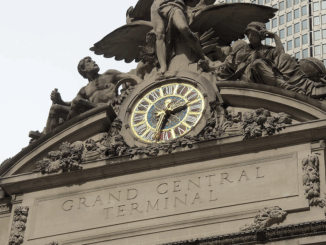
Peter Hitchens at debate on Eastern Europe,
Nigel Luckhurst – Licence CC BY-SA 4.0
Having enough in common with Peter Hitchens to engage in correspondence, I put pen to paper after spying an entertaining railway-orientated thread on his X account. Eventually, he wrote back. Or rather, eventually I found his neglected yellowing reply propped up against a wall in the passageway next to my letter box.
We have been following each other about via minor public schools and embarrassing ‘new’ universities. Peter will tell you he went to York, I’m too humiliated to say. My excuse being, as recounted a couple of episodes ago, our school secretary typed my A-Level options up wrong and I ended up doing subjects I knew nothing of and had no aptitude for.
I doubt Peter’s father, a Royal Navy Commander, or the staff rooms at Mount House School, Tavistock, and The Leys School, Cambridge, pencilled Peter in for Philosophy and Politics at York. The university accepted its first students only a decade before their son and old boy graduated. Mr Hitchens was more likely to be amongst scaffolding and bags of cement than ivy-clad sandstone and statutes of colonial governors.
The good thing about minor fee-paying schools, new universities and the attendant mixture of success, failure and a dispising of formal learning, is that they dispense both self-confidence and a determination to escape. Foreign parts call. Which reminds me of another silly story from school.
One half-term holiday, a boy keen on cars but finding it impossible to pass his driving test, managed to get all the way overland (and sea) to Egypt. Having queued in a post office near the border with Algeria and paid his Egyptian pound, he made it back to school for the start of classes and was able to drive a dilapidated second-hand mini, bought from an impoverished English teacher, on his valid but test-free Egyptian driving licence.
Similarly emboldened, both I and Mr Hitchens were to head east during the Cold War and then feel impelled to return after a wind of change had blown across the continent. In 2010 Hitchens wrote from Sevastopol in the Crimea, by then part an independent Ukraine. Or was it? Treaties determined parts of the isthmus remained under Russian control not least because of the strategic importance of the naval bases there. At about the same time I struck out too, along with the family, to my previous much more comfy Mitteleuropean billet.
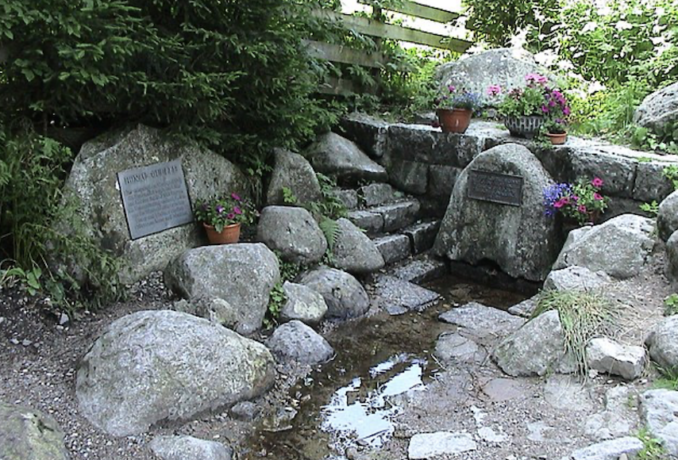
Source of the Breg, larger of two Danube tributaries,
Haseluenne – Licence CC BY-SA 2.0
According to a plaque surrounded by paving flags interupted by a trickle, the Danube begins its 1,770-mile journey from the Black Forrest to the Black Sea at Bregquelle, twenty miles up a valley and across some hills from Freiburg, itself a longish spit from the Rhine in the southern German lander of Baden-Württemberg. These days there is a camping ground, some swings and a restaurant near the Bregquelle – Breg being the name of this longest of headsteams and quelle being the German word for source.
As an aside, am I the only Puffin who assumed Qanon meant ‘Q’ for quelle and ‘anon’ for anonymous?
Gathering its strength, the Danube heads east. As it does so, the second longest river in Europe after the Volga runs through or defines the borders of ten countries. After allowing the Austrians excellent vantages for the likes of Linz and Vienna it separates Hungary from Slovakia before suddenly heading due south as Budapest and Belgrade beckon.
After leaving the Serbian capital, and fortified by the Sava, the great river heads east again, en route dividing Bulgaria from Romania. A delta in the debatable lands between Romania, the Ukraine and Moldova delivers the river to the Black Sea. One hundred and ninety miles across which, at Peter Hitchen’s port of Sevastopol, Russian eyes look west with a mixture of nostalgia and jealousy.
That earlier sudden change of direction, known as the Danube Bend, demands a curve in the railway line useful to my previous purpose. There was a suspicion the strength of the USSR and its unwilling eastern allies was an illusion. Given one hard push, the whole lot might collapse.
Whether through subterfuge or gross inefficiency, all was not what the Soviets reported. Did empty freight trains run long distances from nowhere to nowhere for no greater reason other than to keep up appearances or an inability to overcome the inertia involved in doing otherwise? Mrs Thatcher needed to know!
Dispatched to count the depressed (or not) wagon springs on freight trains, the curves at the Hungarian town of Vac on the Danube Bend seemed just the spot. Back in the day, there was not much in the way of platforms. Gravel, mud and a small amount of ground-level concrete were interrupted by an Iron Road weaving to the border. Double-headed Skoda locomotives thundered through from Czechoslovakia hauling impossibly long trains.
What’s difficult to impress in the written word is the combination of noise and a chilling draught that reaches the bones while the ground shakes and your nose just about touches the wagons. It is great fun – until you need the toilet. And you will. Vibrating innards and moving cold air is as fatal a combination to continency as the likes of Lech Walesa and consumerism are to Communism.
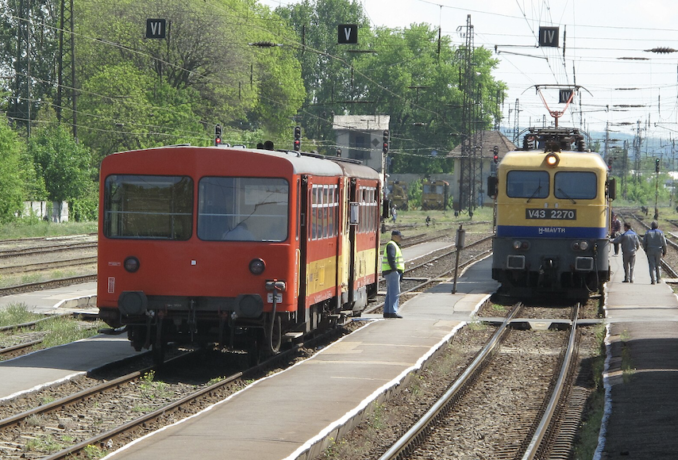
Trains at Vác railway station in 2011,
Dezidor – Licence CC BY-SA 2.0
Something else I have in common with Peter Hitchens is we were both members of extreme left-wing organisations. It’s no secret that Peter became a student Trotskyist. I must hold my hand up too. To use the station facilities at Vac, a gentleman had to find a jobsworth and join the local comune in triplicate.
One assumes Peter joined the Trots because of his schoolboy politics, perhaps motivated by the promise of world peace, the unity of peoples and the creation of a ‘new man’. Less principled, I joined the Communist Party to get my hands on the key to a toilet cubicle at a provincial railway station on account of a different type of trots. Please do not judge me, or tell Mrs Thatcher.
That main line north doesn’t bridge the Danube but keeps to the eastern and then northern banks of the bendy river on the way to Czechoslovakia and passes through Sturovo and its suspicious paper mill on the other side of the border.
Referencing the timetables in my old derring-do box shows the distance from Prague Holesovice to Budapest Nyugati to be 393 miles. The crack expresses took about nine hours, an average speed from point to point of 43 mph. En route, you will pass through the gloriously named Havlickuv Brod and Nove Zamky.
If nine hours and 393 miles in Hard Class isn’t long enough, and/or you need to burn off an overdose of minor public school confidence, can I recommend passing through Vac on the Berlin Lichtenberg to Sofia? By my calculations, which are often wrong, a distance of 1,109 miles which was completed by the Pannonia Express in 44 hours and 23 minutes, an average point-to-point speed of 25 mph.
Photography of anything strategic being forbidden, a travelling gentleman had to memorise his wagon springs for later and then write or illustrate them in code in a jotter. Puffins will recall Baden-Powell’s entomological tour of Ottoman Turkey to draw military fortifications as if the patterns within butterfly wings. A good excuse to wander through the township and scribble in my book beside the banks of the Danube.
Vac railway station to the riverside promenade is a pleasant half-mile stroll through the small Baroque city. Pictured on the right is the Church of the Whites in the main square – a mere 40 years ago. The whites being the white-robed White Friars or Order of Carmelites (I think). The building is an 18th-century church in the baroque-rococo style. Notice a row of Trabants, Polski Fiats and Zastavas.
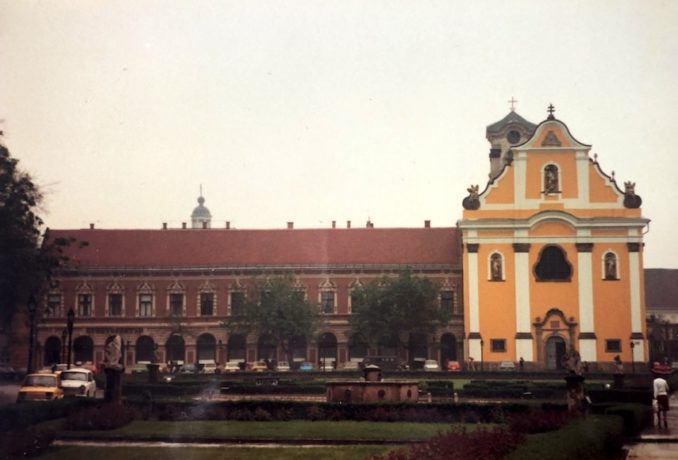
© Always Worth Saying 2024, Going Postal
The sign on the building to the extreme left, above an arch, appears to read Gyógyszertár which would make it a chemist’s.
In the intervening four decades, the square, called Marius Ter, has been re-developed. In the 1990s, during reconstruction works a secret crypt was found. Three hundred coffins thought to be between 170-270 years old were discovered. The coffins did not contain skeletons but intact, naturally mummified bodies.
The lawns and hedges are gone and in their place the exhumed foundations of an earlier church. The chemist’s appears to be an Indian restaurant. The cars are gone too, with the area being paved and pedestrianised. Not so sure I like it.
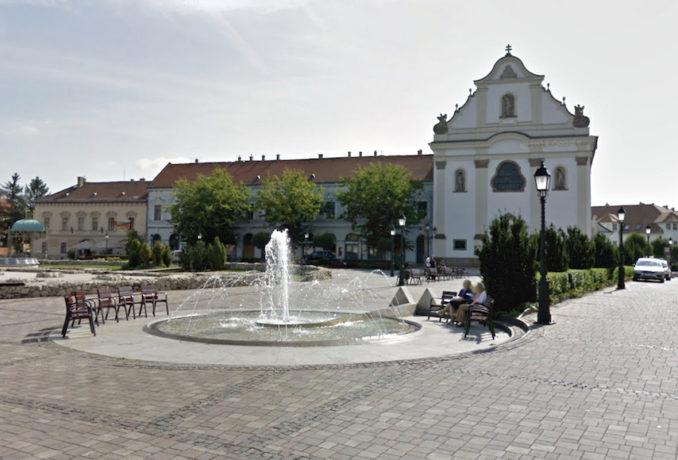
© Google Street View 2024, Google.com
Back in the day, I strolled to the Danube to disguise my calculations before I forgot them. We shall see what lay there next time.
To be continued!
© Always Worth Saying 2024


